|
|
|
|
| Place mouse over 'Training' menu above to display extra options |
| Page Location: Home > Training > Information Sheets > #31 - Registering multiple colour designs/ screens using a jig |
|
|
|
|
| Place mouse over 'Training' menu above to display extra options |
| Page Location: Home > Training > Information Sheets > #31 - Registering multiple colour designs/ screens using a jig |
|
|
|||
|
|
In this example we are going to print a 2 colour design onto a t-shirt.
Important note before you begin
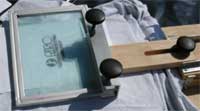 The
location of your design may play an important part on how you layout and
create your screens. The reach of a jig's arm combined with the frame
size you use is important.
The
location of your design may play an important part on how you layout and
create your screens. The reach of a jig's arm combined with the frame
size you use is important.
Left is a screen that has the arm at full extension but still covers the design area with room for registration.
 Pictured
right is a screen where the image is too low and the arm can not travel
any further to reach the design area. This problem is caused by fitting
a design to a frame that is too small for the outreaching areas of the
jig.
Pictured
right is a screen where the image is too low and the arm can not travel
any further to reach the design area. This problem is caused by fitting
a design to a frame that is too small for the outreaching areas of the
jig.
By laying out your design & frames on top of the item in your jig before you begin to print you will avoid this problem.
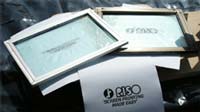 You
can colour separate your design by hand or using computer, details
for both processes are covered on separate NEHOC Training Sheets:
You
can colour separate your design by hand or using computer, details
for both processes are covered on separate NEHOC Training Sheets:Pictured left is the sample design we are using, the 2 screens at the top and a copy of the complete design on paper at the bottom.
![Step 2 - Register your artwork [with all colours] onto the item](step2.jpg) |
Once in place adhere the artwork onto the item with masking tape so it can not move. |
|
Hint |
|
| When registering a design onto a t-shirt, slip the t-shirt over the board just like you would for printing and register the design. Then remove the t-shirt with the designs adhered and actually put it on and look in a mirror or have someone else look at the design to check level. |
For T-shirts [as per example]: Pull the t-shirt onto the board with the artwork attached - this is all you need to do! Proceed to step 4.
For flat items: To ensure the item is placed in the same position each time, we need to create corner/ side registration points on the board that the item will slot up against. Full details of this process are available in Information Sheet #30 - click here . .
|
Important Note |
| Jigs differ in operation between models and functions - the following is based on the NEHOC Single & 4 Arm Screen Printing Jigs. If your jig does not have adjustable arms then you may be required to move your item to a different location on the board before fine tuning the registration in the arm [this applies when using Jig Hinges]. |
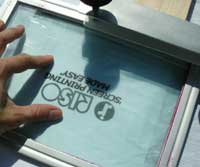 Step
4
Step
4To register the first step is to loosen all the parts of the jig for easy movement.
Place your screen into the jig and move the arm out - when in place tighten to lock in.
Now you can fine tune the registration by moving the screen over the item as pictured. When in place, tighten the arm to lock the screen in place.
|
Hint |
|
If you are required to print 'off
contact' then insert the plastic raisers under the frame
in the screen now before registration. When using the NEHOC Single & 4 Arm Jigs, place a piece of plastic between the frame and the tightening screw - this helps stop movement of the frame when tightening. |
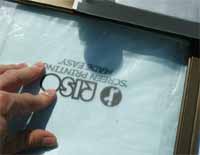 Step
5
Step
5To register the first step is to loosen all the parts of the jig for easy movement. Place your screen into the jig and move the long arm out and when in place tighten to lock in.
Now as with the first screen you can fine tune the registration by moving the screen over the item as pictured. When in place, tighten the arm to lock the screen in place.
Repeat the process above for all remaining colours/ screens. As you can see the process is really the same for 1 - 100 colours - it all depends on your designs and the number of colours you want to have.
You are now ready to begin printing.
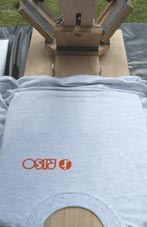 |
Print #1 With your screens aligned and ready to go, perform a test print onto paper over your t-shirts to check the screen. When your screen is ready, remove the paper and perform the first print onto your t-shirt. In this example we used Opaque Orange fabric ink, elevated 4mm using off contact style printing. 2 passes were required with the squeegee to provide sufficient ink coverage. |
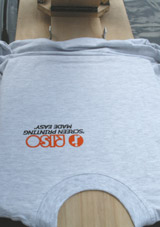 |
Print #2 With the first print performed, swing the 2nd screen round and lower over the design - now perform the 2nd print as per the first. In this example we used Standard Black fabric ink, with no elevation. 3 passes were required with the squeegee to provide sufficient ink coverage on this darker background. When lifting the 2nd, and subsequent, screen for the first time, take a little extra time to see if any of the ink from the first colour 'sticks' to the back of the screen. If this is really heavy & holding the screen as you lift you may need to dry between prints. |